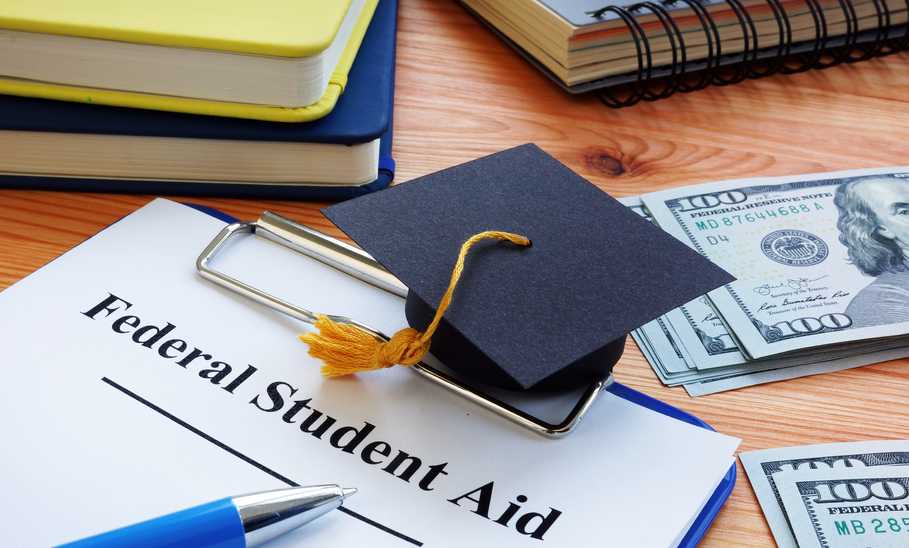FAFSA Deadline 2025: All You Need to Know

Our evaluations and opinions are not influenced by our advertising relationships, but we may earn a commission from our partners’ links. This content is created by TIME Stamped, under TIME’s direction and produced in accordance with TIME’s editorial guidelines and overseen by TIME’s editorial staff. Learn more about it.
Students who use financial aid to pay for college must complete the Free Application for Federal Student Aid (FAFSA) every year. Schools use the information provided on the FAFSA to determine financial aid packages. The FAFSA deadline applies to all student borrowers, both dependent and independent. If you're a parent or guardian applying for a federal PLUS Loan to help a student pay for school, you’ll need to submit the FAFSA by the federal deadline.
The annual FAFSA deadline is June 30 each year, though you have a little extra time to make corrections to your application once you've submitted it.
The FAFSA opening date can vary from year to year, but the annual deadline for submitting your form remains the same. The table below outlines federal FAFSA deadlines; states and colleges/universities can impose different deadlines for submitting your form.
| Year | Opening date | Deadline |
|---|---|---|
2023-24 | October 1, 2022 | June 30, 2024 |
2024-25 | December 31, 2023 | June 30, 2025 |
For the 2025-26 academic year: The FAFSA opening date should be October 1, 2024—a return to the usual schedule. The December 2023 opening date reflected the delayed rollout of the new, updated FAFSA form.
Once the form becomes available, it's important to review the federal FAFSA deadline to understand the first and last date on which you can submit your form. You'll also want to check your school or state's deadlines, as you will likely be required to submit your form well ahead of the federal cutoff date.
The annual FAFSA deadline is June 30 of each year. Application forms remain available on the StudentAid.gov website through the end of each academic year.
As noted above, here are the current FAFSA deadlines:
Should you need to make corrections to your form, there's a separate deadline.
It is confusing that the federal deadline for filing the FAFSA form is the end of the academic year covered by that form, but that is the official policy—we verified it with the Department of Education's support team.
Note that the Department of Ed encourages students to submit their FAFSA as soon as possible after the new application period opens to have the best chances of qualifying for aid. The most relevant dates are those imposed by your state and educational institution..
Schools and states can impose different deadlines for filing the FAFSA. For example, as reported by FederalStudentAid.gov., Arkansas says this about its Arkansas Future Grant: “To be considered for the fall term application, apply before July 1, 2024, midnight CT. For the spring term application, apply by Jan. 10, 2025, midnight CT.”
Since you need to file your FAFSA before any aid is granted, you are likely to encounter similar deadlines elsewhere.
There may be a standard deadline set by the school or state—plus an earlier, “priority” deadline. Schools may set the priority deadline as early as July 1st. The priority deadline is the date students are advised to submit their FAFSA application to get consideration for student aid. Certain types of aid may be first-come, first-served—it's to your advantage to file your form by the priority deadline (or as early as possible).
Thanks to the rollout of an updated FAFSA that was plagued by flaws, many schools and states adjusted their filing deadlines in 2024 to accommodate students and allow more time to file Deadlines are expected to return to normal in 2025 (assuming all of the bugs associated with the new form have been worked out).
The Department of Education has a free online tool to help you find your state's FAFSA deadline. Many states advise students to contact their school's financial aid office to verify the FAFSA cutoff date.
If you’re applying to college for the first time: Get your FAFSA filled out as soon as possible after the form becomes available in October, so that schools will have it when they consider awarding you financial aid. Note that different states (and schools) will likely have different deadlines, so check with each school you are applying to.
If you plan to apply for financial aid, you can submit a FAFSA application online. (You'll need to create a StudentAid.gov account if you don't have one already. As the name implies, creating an account—and submitting an application—is free.)
Once you've created your account, you can log in and begin completing your FAFSA application. Note that anyone who submits information on a FAFSA application needs their own StudentAid.gov account. So, if you're a dependent student, your parents will need to set up an account—separate from your account—to complete their portion of the FAFSA.
Here are the documents you'll need for the FAFSA:
After you've gathered your paperwork, you can start filling out the FAFSA. The StudentAid.gov portal will guide you through the application—and give you a chance to double-check all your information before submitting the form.
If you have questions about filing the FAFSA—or need help with a section of the form—you can visit the Federal Student Aid Information Center (FSAIC). Help is available via live chat, phone, or email.
Filing your FAFSA early is important because certain types of aid may be available only on a limited basis. For example, you might want to qualify for federal work-study to pay for school. Work-study allows you to work in an eligible part-time job and earn money to pay for education expenses.
However, a limited amount of work-study funding is available. You may need to be an “early bird” when filing your FAFSA application to have the best chance of qualifying for work study.
The Department of Education allows you to change your FAFSA under certain conditions. You can make corrections if you:
You can submit FAFSA corrections by logging in to your StudentAid.gov account.
Updates to your financial situation are a little different. If there's been a change to your financial situation or dependency status, you'll need to contact your school's financial aid office. The school should be able to tell you how to update your information, if necessary.
Special circumstances are situations that might affect your financial aid eligibility or package. Examples of special circumstances include:
If you have a special circumstance to report after submitting a 2023-24 FAFSA, you can do so by correcting your form. If you're reporting a special circumstance for the 2024-25 FAFSA, you need to reach out to your school to get an adjustment of your information.
Filing the FAFSA doesn't have to be a headache. These tips can help make the process a little smoother.
Here's one last tip: File the FAFSA even if you don't think you'll qualify for aid. You may be able to get something to help you pay for school, which can reduce what you have to come up with out of pocket.
If you miss the FAFSA deadline, you won't be eligible for federal financial aid. That includes federal student loans and Pell grants.
You can apply for other types of aid to pay for school, including scholarships or state-based aid. If those are insufficient to cover your education costs, look into a payment plan with your school or private student loans.
Private lenders don't require the FAFSA. Instead, your eligibility for student loans is based on credit scores, income, and other factors.
FAFSA deadlines can arrive faster than you’d like, especially if you're not prepared to get your form in. Mark your calendar for your school’s requirements and any priority dates. Proper planning can help you avoid missing the cutoff—so you're not scrambling to find a way to pay for school.
That depends on your school. While the federal deadline for the 2024-25 academic year is June 30, 2025, that’s after the academic year is over. You may still be able to submit a FAFSA and get aid for 2024-25, depending on where you’re registered. If you’ve missed your school’s fall deadline, see if you are in time to get funding for the spring semester.
If you miss the FAFSA deadline, you won't be eligible for federal student aid for the current academic year. However, you can submit a form for the upcoming academic year (as soon as the Department of Education opens the application period).
The official federal FAFSA deadline for fall 2024 is June 30, 2025. But, as noted above, that is after the 2024-25 school year ends. Ideally, you will already have submitted your 2024-25 FAFSA—or will need to do it as soon as possible before fall 2024. If you’re in school now, find out what its deadline is, especially if your school or state has a priority deadline. The application has been available online since December 31, 2023.
The federal FAFSA deadline for 2024 did not change. However, many schools and states adjusted their deadlines to account for hiccups relating to the rollout of the updated FAFSA form. For example, deadlines originally set for March were moved to April or May 2024.
The information presented here is created by TIME Stamped and overseen by TIME editorial staff. To learn more, see our About Us page.



